|
|
|
1.
|
- The average current density is
J = I/A = 20A/p(1.63
x 10-3 m)2 = 2.4 x 106
A/m2.
- vd = J/en = 2.4 x 106 A/m2/(1.6
x 10-19C)(8.47 x 1028 m-3)
=
1.8 x 10-4 m/s.
- E = rJ = (1.56 x 10-8
V-m/A)(2.4 x 106 A/m2) = 0.037 V/m.
|
|
|
2.
|

If the current I1 = 3.0 A in the 4.0 W
resistor,
Vcb = I1 (4.0 W)
= 3.0 A(4.0 W)
= 12 V.
I2 = Vcb/6.0 W
= 12 V/6.0 W = 2.0
A.
I = I1 + I2 = 3.0 A + 2.0 A = 5.0 A.
Vac = IRac = (5.0 A)(5.0 W)
= 25 V.
Vab = Vac + Vcb = 25 V +
12 V = 37 V.
|
|
|
3.
|
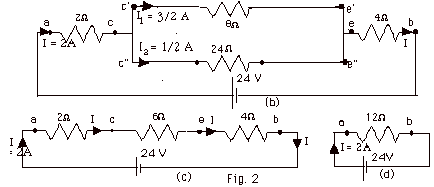
- 2 W is in series with
6 W. Rc’e’
= (2 + 6) W = 8
W.
- 3 W is in series with
the 21 W. Rc”e”
= (3 + 21) W = 24 W.
- Rc’e’ is in parallel with Rc”e”.
1/Rce = (1/8 + 1/24)W-1
= (3/24 + 1/24) W-1.
Rce = 6 W.
- Rab = Rac + Rce + Reb
= (2 + 6 + 4) W = 12
W.
- I = Vab/Rab = 24 V/12 W
= 2 A.
- Vce = IRce = 2A(6 W)
= 12 V = Vc’e’ = Vc”e”.
- I1 = Vc’e’/Rc’e’
= 12 V/ 8 W = 3/2 A.
- I2 = Vc”e”/Rc”e”
= 12 V/24 W =
1/2 A. Note that I1 + I2
= I.
|
|
|
4.
|
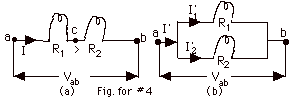
For the resistors in series, the current in each is the same
and the power
P = I2R. Since R1 > R2,
P1 > P2.
When the resistors are in parallel, the current is not the same
in each, but the potential difference across each is the same.
P1 = (I1’) Vab
= (Vab/R1)(Vab) = Vab2/R1.
P2 = (I2’) Vab = (Vab/R2)(Vab)
= Vab2/R2.
Since R1 > R2, now P2
> P1.
|
|
|
5.
|

- The total resistance of the circuit is (9.5 + 20 + 0.5)W
= 30 W.
The current I = 30 V/30 W=
1 A.
- Power dissipated in external resistances =
I2(9.5 + 20)W
= 1 A2 (29.5 V/A) = 29.5 W.
Power dissipated in the internal resistance =
I2(0.5 W)
= (1 A2) (0.5 V/A) = 0.5 W.
Total power dissipated in resistances =
(29.5 + 0.5) W = 30 W.
- Power supplied when chemical energy is changed into electrical
energy = (Emf)(I) = 30 V (1 A) = 30 W.
|
|
|
6.
|

- When both switches are closed, the resistance of the upper
branch of the parallel circuit is (2 + 1) W =
3W and that of
the lower branch is
(2 + 4) W = 6W.
For the parallel group, 1/Req = 1/3 W +
1/6 W and
Req = 2W.
The total resistance of the circuit is (2 + 4) W
= 6 W and
I = 12 V/6 W = 2 A.
- If only switch A is closed, the bottom part of the parallel
grouping is not in the circuit. The total resistance of
the circuit is (2 + 1 + 4) W
and
I = 12/7 A.
- If only switch B is thrown, the top part of the parallel
grouping is not in the circuit. The total resistance of
the circuit is (2 + 4 + 4)
W and
I = 12V/10 W = 1.2 A.
|
|
|
7.
|
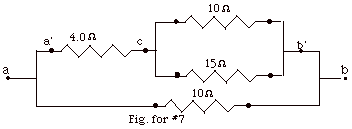
In the Fig. for #7, the 10 W
resistance is wired in parallel with the 15 W
resistance from c to b’. This parallel grouping is then
wired in series with 4.0 resistor between a’ and b’.
Finally this grouping is wired in parallel with another 10 W
resistor.
1/Rcb’ = 1/10 W
+ 1/15 W = (3 +2)/30 W.
Rcb’ = 6 W.
Rab’ = (6 + 4) W
= 10 W.
1/Rab = 1/10 W
+ 1/10 W = 2/10
W.
Rab = 5.0 W
|
|
|
8.
|

For the circuit in Fig. for #8 above, I= e/(r
+ R).
For I = 6.0 A and R = 2.0 W,
6.0 A = e/(r
+ 2.0 W)
(Equation
1)
For I = 3.0 A and R = 7.0
W,
3.0 A = e/(r
+ 7.0 W)
(Equation
2)
From Eq. 1: e =
6.0A r + 12 V. From Eq. 2: e
= 3.0A r + 21V.
Thus, 6.0A r + 12 V = 3.0A r + 21 V. r = 9.0V/3.0
A = 3.0 W.
Substituting r back into Eq. 1, 6.0 A = e/(3.0
+ 2.0) W. e
= 30 V.
|
|
|
9.
|
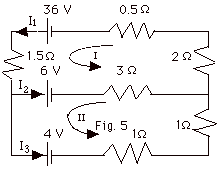
From conservation of charge,
I1 = I2 + I3 or
I3 = I1 - I2
(Equation
1)
For loop I,
36 V - I1(0.5 + 2 + 1.5)
W- 6 V - I2(3 W)
= 0 or
30 A = 4I1 + 3I2
(Equation
2)
For loop II,
6 V + (3 W)I2
- 4 V - (2 W)I3 =
0 or
2A = 2I3 - 3I2 (Equation
3)
Substitute Eq. (1) into Eq. (3):
2A = 2(I1 - I2) -3I2
or
2A = 2I1 - 5I2
(Equation
4)
2 x Eq. 4 equals: 4A
= 4I1 - 10I2
(Equation
5)
Eq. 2 - Eq. 5 equals: 26A
= 13I2 or
I2 = 2A.
Then from Eq. 2: 30A
= 4I1 + 3(2A) and
I1 = 6 A.
From Eq. 1, I3 = 6A - 2A = 4A.
|
|
|
10.
|
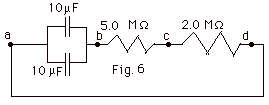
Given q(t) = Qi e-t/RC. When t =
RC, q (RC) = Qi e -RC/RC = Qi
e-1 = Qi/e.
The time constant for the circuit is RC.
- In Fig. 6 above, the two capacitors are in parallel. For
capacitors in parallel, the equivalent capacitance is the
sum of the capacitances.
Cab = (10 + 10)µF = 20µF
= 20 x 10-6 C/V.
The two resistances are in series. The equivalent resistance
of resistances in series is the sum of the resistances.
Rbd = (5.0 + 2.0)MW=
7.0 MW = 7.0 x 106
V/A.
The time constant =
RC = 7.0 x 106 V/A x 20 x 10-6
C/V = 140 C/A = 140 s.
- q(t) = Qie-t/RC. For Qi
= 100 µC and q = 50µC, q/Qi
= 1/2 = e-t/RC
or
et/RC = 2. Taking log of both sides of
this equation, t/RC = ln 2.
t = RC ln 2 = 140 s (0.693) = 97 s.
|
|